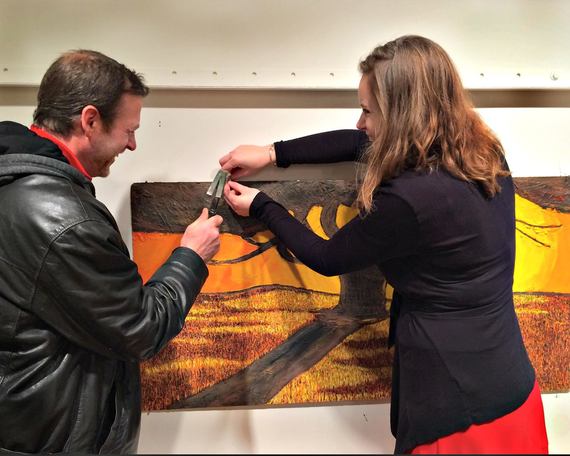From a Shelter Worker: Reflections on Doing Good and Earning Profit
October 20, 2015 22:09
ArtLifting Co-Founder and Chief Happiness Spreader Liz Powers wrote this blog post for The Huffington Post on July 22, 2015.
I have worked with non-profits for 8 years and with homeless individuals for the past 9. During that time, I did a lot of reflecting. I thought about how frustrating it was to feel stifled - how I wanted to make an enormous impact. And move fast.
My job used to be running art groups in homeless shelters. Having to wait a year to hear back regarding grant proposals made moving fast impossible. More importantly, however, I thought about all of my friends in non-profits - how they were doing amazing work, but also how much of the work that they did not generate revenue. I didn't want to compete with them for grants.
I recognize that many non-profits generate revenue in order to survive and grow. But countless non-profits do not have the ability to generate revenue due to the cause they are championing. For example, homeless shelters that support domestic violence victims need to rely on grants.
I find it useful to think about the funding for non-profits with the help of an analogy: all foundation money and other grants are essentially a single pot of money. There are innumerable, worthy non-profits competing for a scoop from that single pot of money - 1.5 million non-profits in the U.S. alone, to be exact. I didn't want to compete against my friends at non-profits for a share of the pot of gold. Anything I received meant my friends would get precisely that much less. One cause's success is effectively another's obstacle.
I didn't want to rely on grant money to grow. I wanted to grow the pot of money.
There are countless talented homeless and disabled artists who need a marketplace to share their work with the community. I needed to solve this problem. Not just in Boston where I'm from, but nationally. And fast. I know so many individuals who can benefit from a marketplace now. Not 5 years from now.
That's why I decided, well aware of the potential for "vilification," to create a for-profit social enterprise - one that would be financially sustainable and scalable. And so we made ArtLifting a Delaware public benefit corporation, a new legal entity that combines high-growth business with a legally binding social mission. So far, it has proven to be the perfect fit. We have a double bottom line: to maximize both impact and financial growth.
At the risk of sounding like someone who is justifying her decision, however, I'd like to share with you the thought-process that led me to choose a for-profit model. For many reasons, I encourage others to realize that there is no need to apologize for using a for-profit entity to support a good cause.
Firstly, if our mission is to benefit both current and future artists, it is imperative that ArtLifting is financially sustainable. As someone who works and sympathizes with homeless and disabled individuals, I understand how easy it can be to want to seek short-term solutions to immediate problems. However, after nearly a decade of working with these individuals, I have come to understand the importance of - yes, it's cheesy - dreaming bigger: seeking long-term solutions to big picture problems. And in order to do that, I learned that I needed to think about revenue generation whenever and wherever possible.
I want to maximize our artists' opportunity to earn their own income. Before we existed, many of the artists we work with had no outlet. The ones that did, were lucky if they could make $20 selling their originals on a street corner. We need to treat these artists with the respect that they deserve. Since we launched just a year a half ago, five of our artists have already gained housing. Original artworks have already sold for as much as $1700. Artists earn endless amounts of money since we sell prints as well as products. Being a benefit corporation is the perfect solution for us.
In considering scalability, we looked to other art companies for inspiration. Part of our value proposition to artists is that we treat them professionally. This isn't charity. Artists earn 55% of the profit from each sale and invest $0 to initiate the sales. ArtLifting artists have the chance to earn their proceeds as professionals. Artist Allen Chamberland explains: "I want to be treated as a regular artist. I know that if you go into a regular gallery they take 50%. I realize that any business has expenses that need to be covered. I don't expect this to be done for free, especially for the scale that it is at now."
We want to treat our artists with dignity. They don't want a hand out - they want to earn their own income. As we've heard from many of our artists, the power to earn generates hope. We view ourselves merely as the vehicle that connects them with the countless customers who love their work.
Social enterprises not only grow the pot of money, but also have the potential to give back to nonprofits. I still remember the helplessness I felt when I was running art groups - many women at the shelters were creating new art and in need of supplies immediately. I could do little else, however, but wait a year to hear back from foundations regarding their sparse grants - I dug through recycling centers to pull together supplies for the season; I posted on craigslist and biked around to strangers' homes to get donations. Often, donated paints were hardened and brushes stiffened. When ArtLifting grows into a large business, we will have the ability to donate high-quality art supplies to art programs across the country. I can't wait.
If you see a need in your community, I recommend that you first take time to reflect on the wealth of potential solutions. Can it generate revenue? If so, go for it. The next question is whether a non-profit or for-profit social enterprise the best fit? Remember that the most meaningful solution is often one that is financially sustainable and scalable. Don't shy away from a for-profit entity for fear of "selling out." A for-profit social enterprise is an investment - it offers the opportunity to grow fast and give back.




